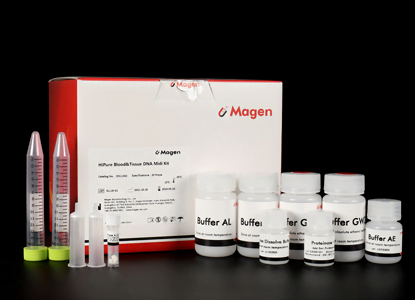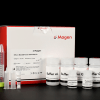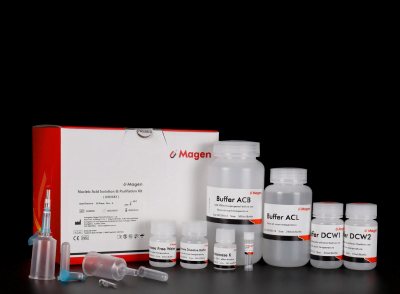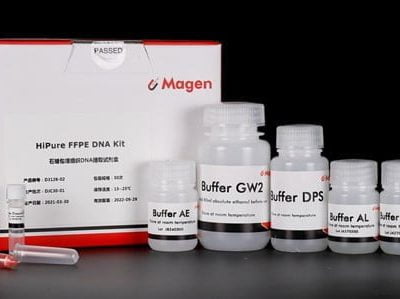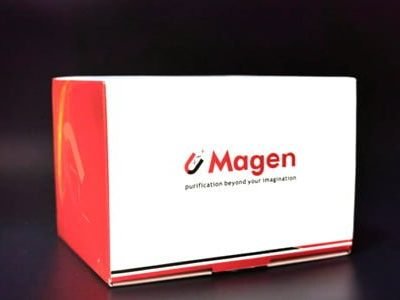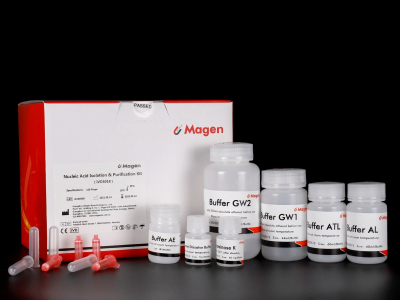Blood is a valuable source of DNA for clinical diagnostics and research, but traditional extraction methods present challenges:
- Safety Hazards: Bloodborne pathogens pose a risk of infection during extraction.
- DNA Loss: Red blood cell removal can eliminate desired DNA fractions (viral, circulating DNA).
- Impurities and Inhibitors: Blood components can interfere with downstream applications (RAP, Southern Blot).
This product offers a novel DNA extraction solution that addresses these issues:
- Safe and Efficient: No red blood cell removal minimizes infectious waste and contamination risks.
- Comprehensive DNA Recovery: Purifies total DNA (génomique, mitochondriale, viral, circulating) for a complete picture.
- Broad Sample Compatibility: Works with whole blood (fresh/frozen), plasma, sérum, couche leucocyto-plaquettaire, et cellules cultivées.
- Downstream Applications: Purified DNA is suitable for PCR and Southern blotting.
This innovative method simplifies blood DNA extraction while ensuring safety, efficiency, and comprehensive DNA recovery. It represents a significant advancement for researchers in diagnostics, forensics, and medical research.
Note: This bulletin corrects the previous statement about sample compatibility. This method is not suitable for tissue samples.
Caractéristiques
| Caractéristiques | Caractéristiques |
| Fonctions principales | Isolation of total DNA from 2ml blood and 200mg tissue using Midi column |
| Applications | RAP, boulon du sud et détection de virus, etc. |
| Méthode de purification | Midi spin column |
| Technologie de purification | Technologie de la silice |
| Méthode de processus | Manuel (centrifugation ou vide) |
| Échantillon type | Tissu, cellules, sang, saliva, swabs, blood spot, semen, and other clinical samples |
| Montant de l'échantillon | 0.2-2 ml |
| Volume d'élution | ≥300μl |
| Temps par course | ≤80 minutes |
| Volume de liquide transporté par colonne | 4ml |
| Rendement de liaison de la colonne | 1mg |
Principles
This product offers a streamlined method for purifying DNA from blood samples using silica column technology.
The Process:
- Lysis and Digestion: The blood sample is treated with a lysate solution and protease to break open cells and degrade proteins, releasing DNA into the solution.
- Binding to Silica: The lysate is transferred to a silica column. The silica membrane in the column selectively binds DNA molecules, while proteins and other impurities pass through.
- Washing: Wash buffers remove unbound proteins and cellular debris that didn’t adhere to the silica.
- Elution: A low-salt buffer (typically 10 mM Tris, pH 9.0, et 0.5 mMEDTA) is used to elute the purified DNA from the silica. This disrupts the interaction between DNA and the silica, allowing the collection of purified DNA in a separate tube.
Avantages
- High-quality DNA – meets a variety of downstream applications, including PCR, qPCR, enzyme digestion, hybridization, etc..
- Rapide – without separation of leukocytes, organic extraction, or ethanol precipitation
- Simple – all nucleic acids can be obtained by direct digestion
- Large applicabilité – handle a variety of liquid samples
Contenu du kit
| Contenu | D311302 | D311303 |
| Temps de purification | 20 | 100 |
| HiPure gDNA Midi Columns | 20 | 100 |
| 15Tubes de prélèvement ml | 40 | 200 |
| Tampon ATL | 50 ml | 250 ml |
| Tampon AL | 50 ml | 250 ml |
| Tampon GW1* | 22 ml | 110 ml |
| Tampon GW2* | 12 ml | 50 ml |
| RNase A | 20 mg | 90 mg |
| Protéinase K | 100 mg | 440 mg |
| Tampon de dissolution de protéase | 10 ml | 30 ml |
| Tampon AE | 20 ml | 120 ml |
Stockage et stabilité
For optimal performance:
- Store Proteinase K and RNase A at 2-8°C (refrigerator) upon arrival.
Acceptable short-term storage:
- Proteinase K and RNase A can be stored for up to 12 weeks at room temperature (15-25°C) without affecting their performance.
Remaining kit components:
- Store all other components of the kit dry at room temperature (15-25°C).
- They are stable for at least 18 mois dans ces conditions.
Important Note:
- If storing the entire kit at room temperature, ensure buffers are redissolved before use and always warm all buffers to room temperature before using them.
Guide d'achat
| Nom | CAT NO | Montant de l'échantillon | Leukocyte protocol* | Colum type | Volume d'élution | Average yield | Temps par course |
| Mini kit d'ADN sanguin HiPure | D3111 | 10-200µl | 1ml | 2ml column | ≥20μl | 5-9μg/200μl | ≤30 minutes |
| Tissu HiPure&Blood DNA Midi Kit | D3113 | 0.2-2ml | 10ml | 1.5ml column | ≥300μl | 20-40μg/1m | ≤80 minutes |
| Tissu HiPure&Kit Maxi ADN Sanguin | D3115 | 3 -10ml | 10ml | 15ml column | ≥700μl | 20-40μg/1m | ≤90 minutes |
| Tissu HiPure&ADN sanguin 96 Trousse | D3117 | 1-200µl | 1ml | 96 well plate | 3-8μg/200μl |
